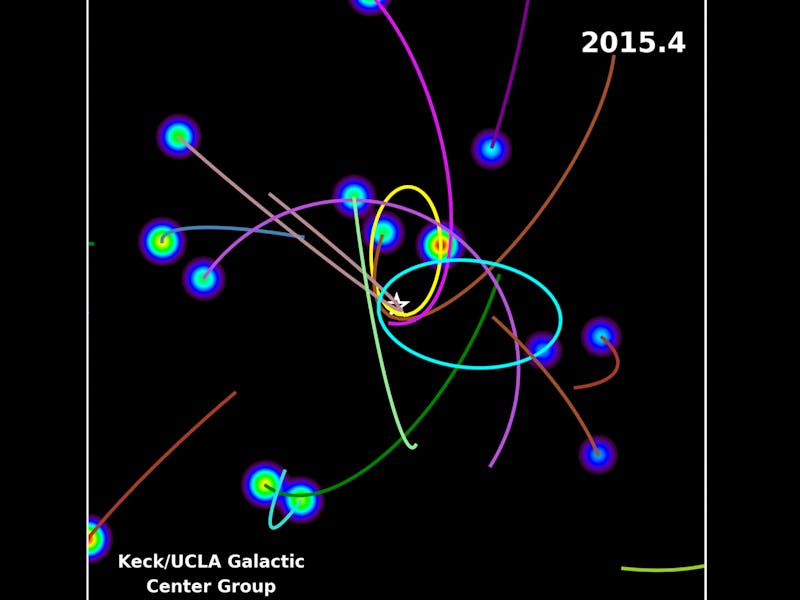Witness the Power of a Supermassive Black Hole in this Animation

By definition, black holes are so horrendously dense that not even light can escape them. And this means we’ve never actually gotten a good look at a black hole — we have no idea what they really look like. Nevertheless, we know what their effects are on their surroundings — and this animation provides a better glimpse of how that works.
The UCLA Galactic Center Group and the W.M. Keck Observatory Laser Team created an animation using images from 1995 to 2013 tracking stars orbiting the supermassive black hole at the Milky Way’s center, called Sagittarius A*. These orbits provide some solid evidence of that black hole’s existence — they move around in ways that can only be explained by the presence of an object in the middle possessing an intense degree of gravitational power.
The European Southern Observatory also captured images of stars orbiting around the black hole over the course of 16 years. The time-lapse below might just look like faded white dots, but it’s actually the images of real stars accelerated by a factor of 32 million.
Nevertheless, we’re still stuck without any data that can give us a direct snapshot of what the supermassive black hole looks like. That might change soon thanks to the upcoming Event Horizon Telescope.
This isn’t like any normal telescope. It’s a global network of nine radio telescopes that together will form a telescope as large as the Earth, and it will produce the first image of the event horizon of the black hole in the center of the Milky Way. Scientists think the black hole might look like this:
Scientists have made steady progress on improving the capability of Very Long Baseline Interferometry (VLBI) at short wavelengths. In other words, they have linked together radio telescopes in different places to create a space telescope and gather data. The final telescopes of the Event Horizon Telescope are expected to come online this spring. We might get our first picture this year.
The black hole above weighs 4 million solar masses, or has the same mass as 4 million suns. And a VLBI detection has marked Sagittarius A*’s likely location. During this decade, scientists plan to probe this region for the black hole’s event horizon. So far, the Event Horizon Telescope has made the first ever measurements of magnetic fields just outside the black hole’s event horizon.
Black holes are still much of a mystery to us. They streak through space, suck up and stretch out stars, and hurl spitballs. Detecting gravitational waves took us one step closer, as they were the first-ever observation of a collision of two black holes. But the Event Horizon Telescope would help us better understand black holes and black hole physics and also advance the study of Albert Einstein’s theory of general relativity. We’ll find out if Einstein was right after all.